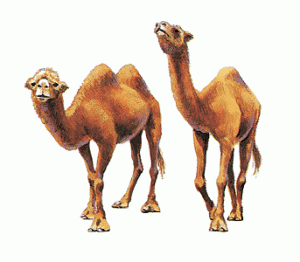God’s Humor in the Camel
Whenever I see a camel, I am reminded that God must have a sense of humor. It is, in my opinion, one of the homeliest animals alive. But, though it may not win a beauty contest, the camel is an amazing and unique creature.
It is called the “Ship of the Desert.” That is because the camel is perfectly suited for desert life. The camel’s nose can be opened or shut to keep sand out. But the nose is also its air conditioner, evaporating moisture to cool its body. The feet also are ideal for walking on sand and are insulated from its heat.
Are There Different Kinds of Camels?
It is easy to keep the two kinds of camels straight. Dromedaries have one hump. Think of a capital D lying on the back of the camel. They are also called the Arabian camel and live in Africa, Saudi Arabia, and southwestern Asia. Bactrian camels are found in Central Asia and have two humps. Think of a capital B lying on its back. Both kinds are ruminants or cud-chewing animals. Of the 17 million camels worldwide, 90% are dromedaries.
An Animal Made for the Desert
A camel can go without drinking for 17 days in the scorching heat, losing a third of its weight, without being affected. This is partly because a camel’s body is not as water dependent as other animals. For example, a cow is 80% water, a donkey 65% water. You and I are 70% water by weight. But a camel’s weight is only 50% water.
When a Bactrian Camel does find water, it can drink 38 gallons of water in seven to eight minutes! This would be like us drinking 6 ½ gallons of water in that amount of time. Now think of Rebekah’s offer to give drink to Abraham’s servant’s camels (Gen. 24). No wonder he was impressed!
Where Do Camels Store the Water?
Camels don’t store the water in their humps. Water is stored throughout their bodies. Fat is stored in the hump very efficiently. A full hump contains 22 to 33 pounds of fat. When this fat is turned to energy, 11.1 grams of water are produced from 10 grams of fat. A camel can also adjust its body temperature, from 93º to 106º, saving over a gallon of sweat in a day.
The camel’s thick eyebrows and eyelashes protect the eyes from sand and sun; the ears have many hairs to keep sand out; the fur is also protective from the sand.
Does the Camel Testify Evolution?
Camels thrive in other environments so there is no reason to think they needed desert conditions to ‘evolve’ their unique features. However, evolutionists don’t see it that way. “The oldest known camel is Protylopus, appeared 40-50 million years ago (Eocene) in North America. It had the size of a rabbit and lived in forests. Later, camels spread to the savanna and increased their size. In Oligocene, 35 million years ago, Poebrotherium had the size of a roe deer, but already resembled a camel.”
Isn’t it much easier to see that God made this animal perfectly adapted to serve man in the harsh conditions of the deserts?
